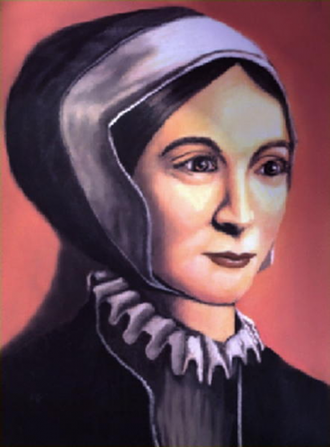Saint Margaret Clitherow, St Fiacre

Martyr. Margaret Clitherow was born in 1555, in Middleton, Yorkshire, into a Protestant family. Her father, Thomas Middleton, was Sheriff of York from 1564 to 1565. Margaret was married at the age of 15 to John Clitherow who had a thriving butchery trade. The couple had three children and lived in The Shambles.
Although her husband remained a Protestant, Margaret converted to Roman Catholicism three years after their marriage, with his blessing. Henry, their son, trained as Catholic priest in France. This was a dangerous time for Roman Catholics; they were constantly pursued and persecuted. Being a fervent Catholic, Margaret assisted both priests and fellow believers, by hiding them in her house. This extended to having a hole cut between the attics of her house and the neighbouring house, to allow for escape in case of a raid. Priests also celebrated secret Masses at her home.
Eventually Margaret was discovered in her 'illegal' practices and was arrested. Standing before the York Assizes, under charge of harbouring Roman Catholic priests, Margaret stood firm and refused to deny her belief; neither would she plead the case as she wished to prevent any trial, which would require her children testifying maybe under their torture. All attempts to force her to deny her faith failed. Her sentence was declared: to be 'pressed to death' on March 25, 1586 (Good Friday), a punishment imposed not for harbouring fugitive priests but one imposed on all who refused to plead. On hearing of her fate Margaret told a friend: "The sheriffs have said that I am going to die this coming Friday; and I feel the weakness of my flesh which is troubled at this news, but my spirit rejoices greatly."
On the day of her execution Margaret was stripped naked and forced flat on her back on top of a large sharp rock; a door was laid on top of her with ever larger stones being added to weight it down. This would have had the effect of making the sharp rock underneath her to pierce and break her spine. She died in great agony after around 15 minutes, though the weights remained in position for many hours after her death.
Her hand was removed after death and is housed as a relic in the Bar Convent's Chapel on Blossom Street. Following her execution, her body was hastily disposed of, but Father John Mush, a priest with connections to the Bar Convent who had once been given safe hiding by Margaret, helped find her body.
The Shrine of Saint Margaret Clitherow can be seen in a house in The Shambles. A commemorative plaque on the Ouse Bridge marks the site of Margaret's martyrdom.
Saint Margaret Clitherow was canonised in 1970 by Pope Paul VI.
Read more about the Shrine here: www.yorkoratory.com/the-st-margaret-clitherow-shrine
And St Fiacre
Irish hermit, patron saint of horticulturist and those suffering venereal disease. St Fiacre sought 'exile for Christ' in the 7th century leaving his native land for France where Bishop St Faro gave him land for a hermitage at Breuil, near Meaux.
St Fiacre was known as a skilful gardener. His cult flourished for many centuries and his devotees included St Vincent de Paul and Anne of Austria.
The place where he lived is now called Saint-Fiacre (Seine et Marne). The hackney carriages which were let for hire were called fiacres because they plied their trade from the Hotel Saint-Fiacres in Paris. The name is still in use to this day.












